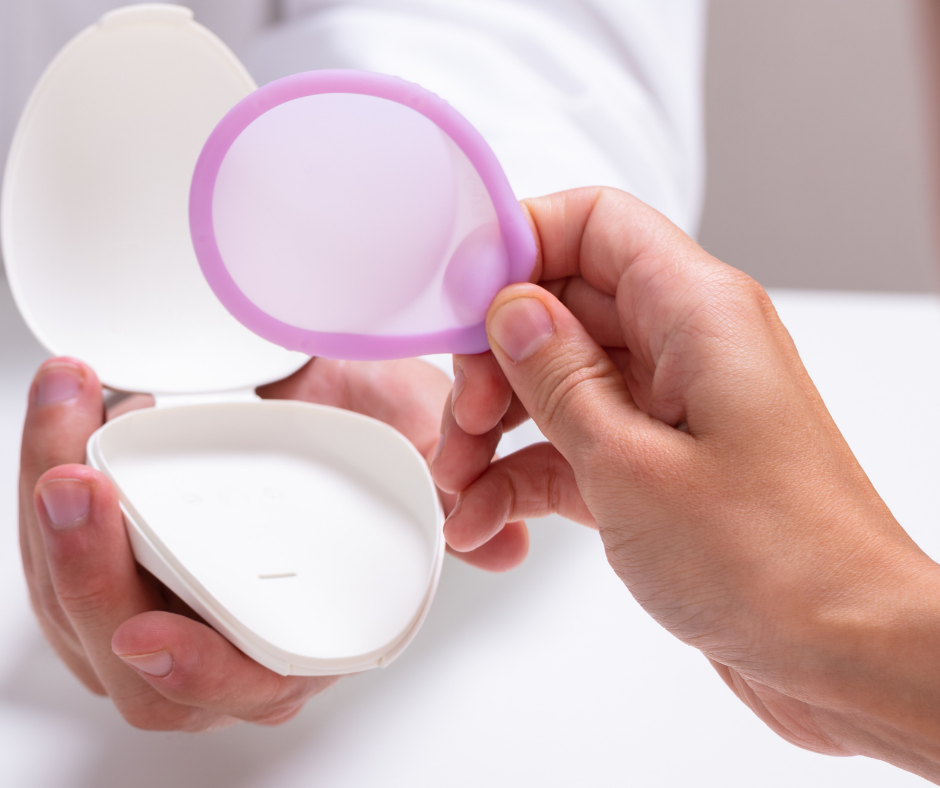Diaphragm
A diaphragm is a shallow cup made of silicone which is placed in the vagina to act as a barrier and prevent pregnancy. It is used with a special gel (a common brand name is Caya Gel).
If used correctly, it is 82% – 86% effective at preventing pregnancy.
How does a diaphragm work?
A diaphragm stops sperm getting into the uterus during sexual intercourse by covering the cervix.
Sperm can live for several hours in the vagina so the diaphragm must be left in place for at least six hours after sex until the sperm in the vagina die.
The manufacturer recommends using Caya gel, a lactic acid based gel that is used on the inside of the diaphragm next to the cervix.
Where can I get a diaphragm?
You can buy a diaphragm from Family Planning Tasmania clinics, some pharmacies or online.
It is recommended that where possible you are assessed by a health professional to make sure the diaphragm fits correctly and to check that you know how to put it in correctly.
The manufacturer provides detailed instructions in the box and on their website about how to use the diaphragm.
Is it right for me?
The diaphragm might not be a good option if you:
- are prone to bladder infections
- gave birth within the last six weeks
- are unable to feel if your cervix is correctly covered by the diaphragm
- have a history of toxic shock syndrome
- have certain types of vaginal prolapse (where the pelvic organs have dropped down)
What can stop a diaphragm from working?
The diaphragm might not work if it does not fit properly or is:
- fitted incorrectly
- torn
- used without the gel
- past its use by date
- taken out less than six hours after sex.
Possible side effects
Possible side effects for a small number of users can include:
- irritation of the vagina or penis
- increased risk of bladder infection learning.
The diaphragm can cause a very rare blood infection called toxic shock.
It is important that you do not leave the diaphragm in the vagina for any longer in than 24 hours.
How do I insert a diaphragm?
- Apply lubricant gel to the upper surface.
- Use the dimple grips to squeeze the rim together.
- Insert the diaphragm into the vagina & guide it back & up towards the small of the back as far as it will go.
- Tuck the diaphragm behind the pelvic bone at the front of the vagina.
- Check that the cervix is completely covered by feeling with your fingers.
How do I remove a diaphragm?
- Leave the diaphragm in place for at least 6 hours after sex.
- Hook your index finger into the dome to pull the diaphragm out.
- Wash the diaphragm with warm water and once dry, put it away in its case.
Looking after your diaphragm
After use:
- wash the diaphragm with warm water & plain unperfumed soap
- don’t wash it with disinfectants, detergents, powders or perfumed soaps
- rinse and leave it to air dry thoroughly
- check it for any holes or signs of wear
- if it feels sticky it needs replacing
- put it away in its case and store it in a cool place.
What if the diaphragm moves during sex?
If the diaphragm moves out of place, tears, or is not used properly, you should think about using emergency contraception (also known as the morning after pill).
You may find the following documents useful:
Diaphragm Factsheet
Contraceptive choices overview
If you want to know more about which type of contraception might work best for you, or if you have more questions about using a diaphragm, you can speak with one of our friendly doctors. Click here to find your closest clinic and make an appointment.
This content is provided for general information and education purposes only and does not take into account individual circumstances. It is not to be relied on in substitution for specific advice from a medical professional and Family Planning Tasmania does not accept responsibility for such use. Family Planning Tasmania has taken every effort to ensure that the information is up to date and accurate, however information and knowledge is subject to change. Family Planning Tasmania advises that you always consult a medical professional for individual advice.
This content is provided for general information and education purposes only and does not take into account individual circumstances. It is not to be relied on in substitution for specific advice from a medical professional and Family Planning Tasmania does not accept responsibility for such use. Family Planning Tasmania has taken every effort to ensure that the information is up to date and accurate, however information and knowledge is subject to change. Family Planning Tasmania advises that you always consult a medical professional for individual advice.
Related topics
We're here for you at every stage of life
We have clinics in Burnie, Launceston, and Hobart. Interpreter services available.


